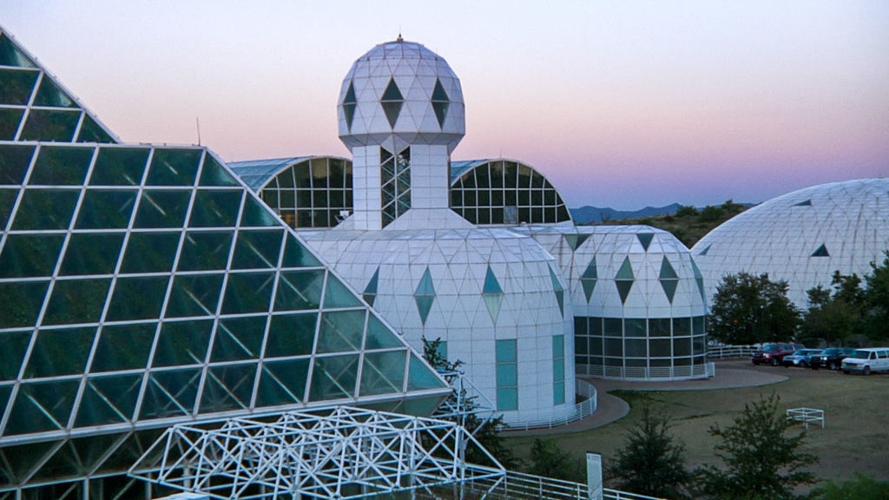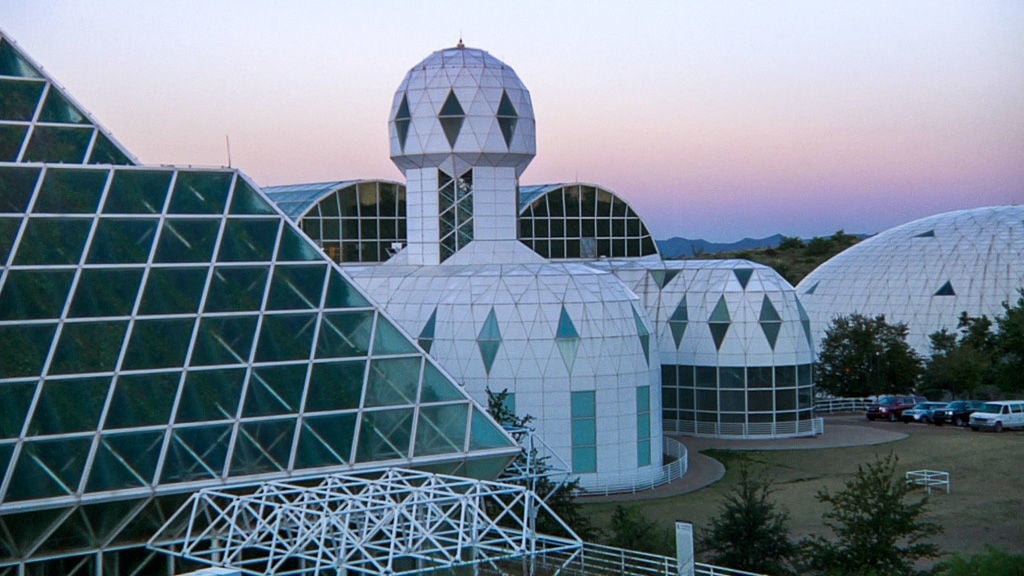In the 25 years since the first enclosure of eight people inside Biosphere 2 came to an end, Columbia University and now the University of Arizona have tried to rebrand the unique space as a tool for relevant science about Earth under the pressures of climate change.
The UA’s nearly 12 years of management of the glass-enclosed research center north of Tucson near the town of Oracle has been laborious but fruitful, and its leaders now believe it is poised to become an important hub for science, technological development and outreach.
Despite the drama of the Biosphere under the original management in the early 1990s, many saw the facility’s scientific potential early on.
Columbia managed the facility from 1996 to 2003 and remade the mission and image of Biosphere. It released prominent, well-received research papers demonstrating new uses for the facility, said John Adams, Biosphere’s deputy director.
Despite this, Wallace Broecker, Biosphere’s science adviser under Columbia who is often described as the grandfather of climate science, described one occasion when a peer reviewer declined to publish Broecker’s research article because the reviewer didn’t trust the science being done at the facility.
Many critics of Biosphere correctly point out that some of the science conducted at the facility can’t be replicated elsewhere, which is standard practice in science.
“But a lot of great science had been done, and a foundation had been established that could be built on,” Adams said of Columbia’s time there.
So when Joaquin Ruiz, dean of the UA’s College of Science and the director of the Biosphere, heard the Biosphere was seeking new management, he wasn’t bothered by scientists not being able to reproduce exactly what was done within its walls. He instead saw Biosphere’s unique science that couldn’t be done anywhere else as an asset.
The UA is now Biosphere’s longest-running owner.
UA takes the lead
The first large UA-led endeavor at Biosphere was the Landscape Evolution Observatory, and it was a huge undertaking.
Crews filled three 100-foot steel beds with 1 million pounds of meter-deep crushed volcanic rock with an array of sensors buried within, above and below the apparatus. The project cost more than $7 million and was completed in 2012 after five years of planning and construction. The observatory is situated where the eight biospherians once grew crops, but researchers now hope to understand how climate change may impact water resources and ecosystems in dry environments, and more.
Revamping the Biosphere’s ocean for new experiments is the next area of focus in the next two years.
The world’s biggest controlled marine research facility contains 700,000 gallons of water, bursts with overgrown algae and relies on ocean-dwelling critters to clean it up. The space is being prepped to breed super coral that can withstand ocean acidification.
“When you see large die-off events on reefs, there are always individuals that survive,” Adams said. “Their traits allow them to deal with those changing conditions. The question is, ‘How can we selectively breed super coral to populate areas that have degraded and died?’”
Biosphere is suited for this endeavor because it is too risky to test genetically manipulated species in a wild environment because you don’t know how they will proliferate, and no aquarium would sacrifice its reefs to test ideas, Adams said.
Further down the road, Ruiz envisions using the rainforest to study coffee and chocolate farming. “They’re taking a beating because of global climate change,” he said.
There are also plans to use the facility’s rainforest to study how soil fertility is affected by the changes in microbial communities as carbon dioxide levels fluctuate.
Additionally, Gene Giacomelli, UA professor of biosystems engineering, has been working with the Biosphere for years on modular greenhouses for potential lunar use as well as vertical farming techniques.
While there are no plans to seal the Biosphere off from the outside — its original purpose — the legitimate science being done there now is still exploring the original creators’ concerns.
“Corals in the ocean is one of the things that the Biosphere has been worried about for 25 years,” Ruiz said. “The Biosphere was also very worried about food. It used to be, ‘How do you keep eight people alive for 2½ years?’ Now, we’ve just changed the question to, ‘How do you keep 8 billion people alive forever?’”
The UA has managed the Biosphere for more than a decade and has many research papers published as a result, but only one large section of the biosphere, the landscape observatory, has been thoroughly developed by the UA.
Realizing his goals for Biosphere have been “too slow,” Ruiz said. “Setting up any experiment is really expensive. (The landscape observatory) cost more than $7 million. To fix the ocean, it’s going to cost $5 million.”
With the Biosphere, “you can try almost anything, but anything you do try is going to be challenging,” he said.
Looking forward
Some of the UA’s newest plans include developing the B2 Institute, an umbrella organization for the university dealing with sustainable agriculture and development.
“We’re still in the midst of formalizing the idea, but we hope to foster and grow public/private partnerships, and leverage the university’s expertise,” Adams said.
Biosphere 2 Enterprise Hub, in partnership with Eller College of Management, will fall under the B2 Institute umbrella, Adams said. It will be a business incubator in the Roy Place building in downtown Tucson. “The idea is that a presence downtown, in close proximity to the university as well as other entities looking to grow and expand, has its advantages.”
Ruiz said, “We haven’t realized the whole potential of the Biosphere as a whole facility or as a think tank. We’re working on that. But I’m excited because right now we’re on a trajectory where all these things might start happening very quickly.”
The way he sees it, there are a few things working in the Biosphere’s favor.
Those who manage the biosphere all agree that this administration “just gets it,” as Ruiz put it. President Robert Robbins is focused on preparing students and the university for the Fourth Industrial Revolution where the physical, digital and biological spheres converge. “When I came forward with the idea of getting the Biosphere about 12 years ago, that administration thought it was crazy.”
Additionally, Edward Bass, heir to an oil fortune and Biosphere’s original benefactor, donated the facility to the UA last year, and gifted the UA $30 million for the facility. All of that money is now held within the UA Foundation. Every year, a percentage of that endowment spins off and goes back into a fraction of the total operational costs of the Biosphere, Adams said, which is $5 million.
Additionally, the UA is hiring new researchers to focus their study at the Biosphere full time.
“Now, we have the horsepower so that it’s not just John (Adams) and I running around trying to do everything,” Ruiz said.
With each new big endeavor, such as the landscape observatory or the ocean reefs, Biosphere leadership — including Adams, Ruiz and Peter Troch, Biosphere’s science director — builds up an network of researchers to manage the new initiative.
Maintaining relevancy
Many new hires are beginning their careers at the UA as faculty and at Biosphere.
UA assistant professor of ecosystem genomics Laura Meredith studies microbes and will lead the rainforest development. Diane Thompson, assistant professor of geosciences, researches corals and will oversee the ocean.
“A lot of the new hires are telling us they can’t do the work they want to do anywhere else,” Adams said.
The Biosphere also hopes to grow its K-12 programs, and ticket sales have been on the rise.
About 100,000 visitors walked beneath the glass domes last year. The numbers have been growing steadily.
Later this year, the Biosphere is planning to partner with dancers to put on five-minute shows for tours, and a half-hour evening performance.
Biosphere’s leadership still pushes back against the narrative that it was a failed experiment in the 1990s. “There’s no such thing as a failed experiment,” said Adams and Ruiz.
“The single most important lesson we learned from the Biosphere was just how complex earth systems actually are and how little we understand them,” Adams said. Now, the UA has was a unique ecological tool and an opportunity to share earth science with the public.
“Even though we’re talking about the 25-year anniversary of that group of eight people who took this remarkable journey and sealed themselves inside,” Adams said, “in my opinion, the real story is about how the Biosphere has been able to be repurposed over all these years and still have relevance.”







